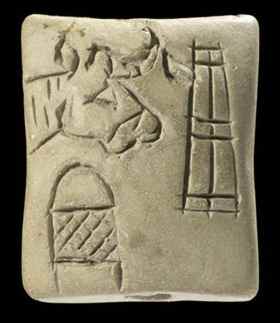One of the stars of the Oriental Institute's new show, "Visible Language: Inventions of Writing in the Ancient Middle East and Beyond," is a clay tablet that dates from around 3200 B.C.
 On it, written in cuneiform, the script language of ancient Sumer in Mesopotamia, is a list of professions, described in small, repetitive impressed characters that look more like wedge-shape footprints than what we recognize as writing.
On it, written in cuneiform, the script language of ancient Sumer in Mesopotamia, is a list of professions, described in small, repetitive impressed characters that look more like wedge-shape footprints than what we recognize as writing.
In fact "it is among the earliest examples of writings that we know of so far," says institute director Gil Stein, and it provides insights into one of the world's oldest cultures.
The exhibition by the institute, part of the University of Chicago, is the first in the U.S. in 26 years to focus on comparative writing. It relies on advances in archaeologists' knowledge to shed new light on the invention of scripted language and its evolution.
The show demonstrates that, contrary to the long-held belief that writing spread from east to west, Sumerian cuneiform and its derivatives and Egyptian hieroglyphics evolved separately from each another. And those writing systems were but two of the ancient forms of writing that evolved independently. Over a span of two millenniums, two other powerful civilizations - the Chinese and Mayans - also met a need for written communication. Writing came to China as early as 1200 B.C. and to the Maya in Mesoamerica long before A.D. 500.
"It was the first true information revolution," Stein said. "By putting spoken language into material form, people could for the first time store and transmit it across time and space."
 The exhibition, which runs through March 6, focuses heavily on the Sumerian civilization that flourished between 3500 B.C. and 1800 B.C. in what is now southern Iraq. Until the 1950s experts had believed the Sumerians influenced the Egyptians, spreading the use of writing westward. But in the 1950s Gunther Dryer, a German archaeologist, found writing on bone and ivory tags in an elaborate, probably royal burial site at Abydos in southern Egypt.
The exhibition, which runs through March 6, focuses heavily on the Sumerian civilization that flourished between 3500 B.C. and 1800 B.C. in what is now southern Iraq. Until the 1950s experts had believed the Sumerians influenced the Egyptians, spreading the use of writing westward. But in the 1950s Gunther Dryer, a German archaeologist, found writing on bone and ivory tags in an elaborate, probably royal burial site at Abydos in southern Egypt.
The pieces are as old as Sumerian works. Because the marks were different in style, scholars believe that the Egyptians developed their writing system independently.
Experts are still struggling to understand just how writing evolved, but one theory, laid out at the exhibition, places the final prewriting stage at 3400 B.C., when the Sumerians began using small clay envelopes like the ones in the show. Some of the envelopes had tiny clay balls sealed within. Archaeologists theorize they were sent along with goods being delivered; recipients would open them and ensure the number of receivables matched the number of tokens. The tokens, examples of which are also are in the show, transmitted information, a key function of writing.
Writing as a carrier of narrative did not evolve for another 700 years, as shown in the inscribed versions of the Sumerian epic tale of Gilgamesh, also on display in the institute's general collection.
Although Egyptian hieroglyphics are more broadly familiar than cuneiform, Sumerian writing was done on clay, which is more durable than papyrus. As a result, Sumer is among the best documented of ancient societies.
Part of the exhibition's allure is that it describes some of the unknowns that still intrigue archaeologists, including the birth of the alphabet.
Author: Geraldine Fabrikant | Source: Charlotte Observer [November 21, 2010]